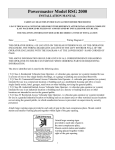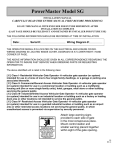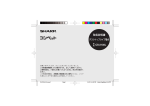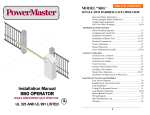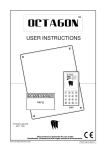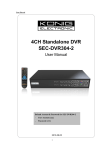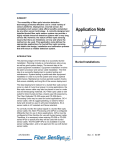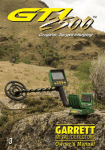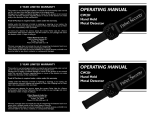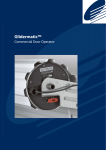Download PowerMaster Model BSG
Transcript
PowerMaster Model BSG INSTALLATION MANUAL CAREFULLY READ THIS ENTIRE MANUAL FIRST BEFORE PROCEEDING! LEAVE THIS MANUAL WITH END USER FOR FUTURE REFERENCE AFTER INSTALLATION IS COMPLETE (LAST PAGE SHOULD BE FILLED OUT AND RETAINED BY INSTALLER FOR FUTURE USE) THE FOLLOWING INFORMATION SHOULD BE RECORDED AT TIME OF INSTALLATION: Date: Serial #: Wiring Diagram #: THE OPERATOR SERIAL # IS LOCATED ON THE ELECTRICAL ENCLOSURE COVER. THE WIRING DIAGRAM IS LOCATED INSIDE COVER WITH THE DIAGRAM # AT THE LOWER RIGHT- HAND CORNER OF PAGE. THE ABOVE INFORMATION SHOULD BE GIVEN IN ALL CORRESPONDENCE REGARDING THE OPERATOR TO INSURE FAST SERVICE WHEN ORDERING PARTS OR REQUESTING INFORMATION. The above identified unit is rated in the following class: [ X ] Class I- Residential Vehicular Gate Operator -A vehicular gate operator (or system) intended for use in a home of one to four single family dwellings, or a garage or parking area associated therewith. [ X ] Class II- Commercial/General Access Vehicular Gate Operator -A vehicular gate operator (or system) intended for use in a commercial location or building such as a multifamily housing unit (five or more single family units), hotel, garages, retail store or other building servicing the general public. [ X ] Class III- industrial/limited Access Vehicular Gate Operator -A vehicular gate operator (or system) intended for use in an industrial location or building such as a factory or loading dock area or other locations not intended to service the general public. [ X ] Class IV- Restricted Access Vehicular Gate Operator -A vehicular gate operator (or system) intended for use in a guarded industrial location or building such as an airport area or other restricted access locations not servicing the general public, in which unauthorized access is prevented via supervision by security personnel. WARNING Moving Gate Can Cause Serious Injury or Death. KEEP CLEAR! Gate May Move at Any Time. Children Should Not Play in Gate Area or Operate Gate. Operate Gate Only When Area is in Sight and Free of People and Obstructions. Attach large warning signs provided to each side of gate in the most conspicuous place. Mount control station and smaller warning placard together within sight of the gate opening. BSG REV. D Important! SAFETY INSTRUCTIONS FOR SLIDE GATE OPERATING SYSTEMS SAFETY IS EVERYONE'S BUSINESS Automatic gate operators provide convenience and security to users. However, because these machines can produce high levels of force, it is important that all gate operator system designers, installers, and end users be aware of the potential hazards associated with improperly designed, installed, or maintained systems. Keep in mind that the gate operator is a component of a total gate operating system. The following information contains various safety precautions and warnings for the system designer, installer, and end user. These instructions provide an overview of the importance of safe design, installation, and use. Warnings are identified with the symbol . This symbol will identify some of the conditions that can result in serious injury or death. Take time to carefully read and follow these precautions and other important information provided to help ensure safe system design, installation, and use. WARNING: Gate operators are only one part of a total gate operating system. It is the responsibility of the purchaser, designer, and installer to ensure that the total system is safe for its intended use. All secondary entrapment safety devices must be U/L recognized to complete the operating system. SYSTEM DESIGNER SAFETY INSTRUCTIONS 1. Familiarize yourself with the precautions and warnings for the installer. Users are relying on your design to provide a safe installation. 2. The operator is supplied with a primary current sensing entrapment protection system. The installation must also have a secondary entrapment protection system installed, such as photoelectric sensors or an electric edge system (See Page 8 & 9). 3. When designing a system that will be entered from a highway or main thoroughfare, make sure the system is placed far enough away from the road to eliminate traffic backup. Distance from the road, size of the gate, usage levels, and gate cycle/speed must be considered to eliminate potential traffic hazards. 4. The majority of injuries from slide gate operator systems occur with Open Rollers or Ornamental Grill Type Gates. The illustrations and descriptive captions found on the following pages provide precautions to help eliminate injuries or fatalities. Familiarize yourself with them when designing the total system. 5. Design gate systems so a person(s) cannot reach through the gate to operate any controls. Never place controls on the gate operator itself. -1BSG REV. D INSTALLER SAFETY INSTRUCTIONS A. Before Installation 1. Check to see that the operator is proper for this type and size of gate and its frequency of use. If you are not sure, consult factory. 2. Check to see that there are no structures adjacent to the area, which may pose a risk of entrapment when gate is opening or closing. 3. You must ensure that the gate has been properly installed and works freely in both directions. Repair or service any worn or damaged gate hardware prior to installation. A freely moving gate will require less force to operate and enhance the performance of the operator as well as the safety devices used within the system. 4. Install the gate operator on the inside of the property and/or fence line. DO NOT install an operator on the public side of the gate. 5. The operator is supplied with a current sensing primary entrapment protection system (See Page 8). Additional safety equipment such as electric edges or photocell sensors must be installed to provide the required secondary entrapment protection system (See Page 8 & 9). Severe injury or death can result from entrapment by gate. For assistance in selecting the correct type of safety equipment, consult the factory. 6. Review the operations of the unit and become familiar with the manual disconnect mechanism and safety features of the system. 7. You must install a push-button control or key switch to allow for normal operation of the gate if the automatic controls do not work. Locate the push button or key switch and small warning placard within sight of gate in a secured area at least 10 feet or more from the gate and fence to keep users away from the moving gate. 8. Outdoor or easily accessed gate controls should be of security type to prohibit unauthorized use. B. During Installation 1. Be aware of all moving parts and avoid close proximity to any pinch points. 2. Disconnect power at the control panel before making any electric service connections. Connection locations for controls and safety equipment can be found on the wiring diagram., and in this manual (See Pages 7,8 & 9) 3. Know how to operate the manual disconnect mechanism (See Fig. 6). 4. Adjust the open and close current sensors on the PC control board in each direction to the minimum force required to operate the gate smoothly (See "PRIMARY OBSTRUCTION SENSING DEVICE" Fig. 8). DO NOT increase current setting to makeup for rough spots in gate travel- FIX THE GATE INSTEAD! 5. Place controls at least 10 feet from the gate so that the user can see but cannot touch the gate while operating the controls. 6. Place the warning signs provided in high visibility areas on each side of the gate to alert motorists and pedestrians of automatic gate operation. C. After Installation 1. You are responsible for ensuring that the end user understands the basic operations and safety systems of the unit, including the location and operation of the manual disconnect (See Fig. 6). 2. Point out that the safety instructions in brochure are the responsibility of the end user, and then leave a copy of this brochure with the end user. -2BSG REV.D SAFETY WARNINGS FOR OPEN-ROLLER GATES AND ORNAMENTAL GRILLE-TYPE GATES INJURIES ASSOCIATED WITH AUTOMATIC GATES CAN OCCUR WITH OPEN-ROLLER GATES AND ORNAMENTAL "GRILLE TYPE" GATES OPEN-ROLLER GATES Injuries occur when people get their hands caught between the top of the gate and the roller. This potential pinch point should be guarded whenever an automatic operator is installed. Enclosed tracks are available from various fence suppliers for refitting of these rollers. ROLLER GUARD COVER TO PROTECT FROM PINCH POINT HAZARD VERTICAL POST PLACED ON BOTH SIDES OF EXPOSED ROLLERS CAN PROTECT HANDS FROM REACHING THESE PINCH POINTS. ELECTRIC EDGE PLACED ON THESE POSTS CAN BE WIRED TO REVERSE THE UNIT UPON CONTACT. ELECTRIC EDGE ELECTRIC EDGE ROLLER GUARD COVER TO PROTECT FROM PINCH POINT HAZARD ORNAMENTAL "GRILLE TYPE" GATES Injuries occur when people put their arms through openings in the grilles and the gate is operated. The person cannot retract his/her arm and it gets caught between the grille and the fence post or fence. The potential hazard must be guarded. It can be simply done by placing a screen mesh on the gate and fence in the area of the gate. The screen must be a minimum of 4 feet high from the bottom (unless the gate and fence are shorter) with openings that a 2-1/4 inch sphere cannot fit through (See Illustration Below). This will help to prevent access through openings when the gate travels. ELECTRIC EDGE INSTALLATION INSTRUCTIONS: WARNING: DO NOT APPLY POWER UNTIL TOLD TO DO SO! RISK OF ELECTRICAL SHOCK OR INJURY MAY RESULT. IMPORTANT: BEFORE INSTALLING OPERATOR: Gate must slide freely to fully opened and fully closed position. Gate and/or extension must extend beyond the operator location as shown in fig.1, fig. 2, and fig. 3. Operator will be placed as shown, in fig. 1 page 5, for left and right hand installation. -4- BSG REV. D FENCE FENCE OPENING XXXXXXXXXXXXXX GATE EXTENSION FOR LEFT HAND INSTALLATION LEFT HAND OPERATION INSTALLATION GATE EXTENSION FOR RIGHT HAND INSTALLATION RIGHT HAND OPERATION INSTALLATION GATE SLIDE LEFT TO OPEN (L.H. INSTALLATION) Figure 1 SLIDE RIGHT TO OPEN (R.H. INSTALLATION) CEMENT PAD: Lay out per drawing (See Fig. 2 & 3). Be sure top surface is level. Allow 2 days cure time before installing operator. Bolt pattern must be parallel to gate as shown in (Fig. 2). INSTALLATION TO PAD: (1.) With cover removed, assemble power head on stand (shown in figure 4) with 3/8 inch hardware. (2.) Using 1/2" hardware (not supplied), bolt assembled unit to pad, being sure to center unit on cement pad (See Fig. 2 & 3). Note: sprockets must face fence. GATE LEADING EDGE MIN. SIDE ROOM REQUIRED = GATE OPENING +A +B +32" A GATE OPENING B 32" MIN. FENCE GATE EXTENSION GATE GATE TRAILING EDGE 6-1/2" CL 4 OF DRIVE CHAIN GATE BRACKET 14" 1 DRIVE SPROCKET GATE BRACKET 10-1/2" SLIDE GATE OPERATOR DRIVE CHAIN 8" GATE EXTENSION 4 2 IDLER SPROCKETS 8" 10-5/8" 12-3/4" 18" 26" CEMENT PAD 16" X 30" GROUND LINE 1 3" O.D. PIPE, EXTENDING MIN. 18" ABOVE GROUND, REQUIRED FOR OPTIONAL POST MOUNTING (2) PLACES. 2 1/2" FASTENING HARDWARE (4) PLACES (NOT SUPPLIED). DEPTH AS REQUIRED BY LOCAL CODE Figure 2 GATE BRACKET CONDUIT DEPTH AS REQUIRED BY LOCAL CODE CEMENT PAD Figure 3 #41 CONNECTING LINK INSIDE 3/8" NUT GATE BRACKET OUTSIDE 3/8" NUT CHAIN TAKE-UP BOLT LOCK WASHER "BSG" STAND ASSEMBLY 3 3 THESE HOLES FOR USE WITH PIPE MOUNT INSTALLATION (TYPICAL BOTH ENDS) 4 INSTALL CHAIN SUPPORT BRACKETS AS REQUIRED (CHAIN SUPPORT BRACKET) Figure 4 WASHER WASHER Figure 5 ATTACHING CHAIN (1.) Install gate bracket per figure 2 and 3. Do not fully tighten at this time. (2.) Attach a chain take up bolt to drive chain using a #41 connecting link (See Fig. 5). (3.) Install chain take up bolt into in furthest gate bracket, and secure into position with 3/8 inch washers, and nuts (See Fig 5). (4.) Disengage operator by moving the red disconnect lever (located on the operator frame) to the disconnect position, and latch in place (See Fig. 6, page 6). (5.) Thread free end of chain under first idler sprocket, up and over drive sprocket. then under second idler sprocket as shown (See Fig. 3). -5- BSG REV. D ATTACHING CHAIN CONT.: Note: When threading chain through operator sprockets, the limit nuts in the electric box can be driven past their normal position. Reset limit nuts as necessary (See Limit Adjustment, page 10). (6.) Pull chain through to opposite end of gate. Cut chain to correct length and install in gate bracket as in steps 2 and 3. (7.) Check gate bracket height at both ends of gate to be sure that chain aligns with the operator (See Fig. 3). (8.) Tighten gate brackets securely. (9.) Adjust chain tension with 3/8 inch outside nuts so that the chain sags slightly and install chain support brackets (See Fig. 3, 4 and 5). (10.) Check chain and sprocket alignment at both ends of gate and tighten 1/2" inside nuts against gate brackets to secure position (See Fig. 2 and 5). PADLOCK OPTION HOLE TO DISCONNECT DRIVE: MOVE LEVER TO THE LEFT. TO MAINTAIN DISCONNECTED POSITION, LIFT AND HOOK LEVER BEHIND HEAD OF DISCONNECT RETAINING BOLT. DISCONNECT RETAINING BOLT TO RE-ENGAGE DRIVE: MOVE LEVER DOWN AND TO THE RIGHT. DISCONNECT LEVER BSG OPERATOR DISCONNECT LEVER OPERATION Figure 6 -6- BSG REV. D HIGH VOLTAGE WIRE GAUGE/ DISTANCE CHART 16 AWG: 14 AWG: 12 AWG: 10 AWG: 8 AWG: Up to 100' 100'-350' 350'-500' 500'-900' 900'-1200' Over 1200' consult factroy ELECTRICAL CONNECTIONS: WARNING: DO NOT APPLY POWER UNTIL TOLD TO DO SO! RISK OF SHOCK OR INJURY MAY RESULT. Before connecting the operator, use a voltmeter to determine that the electrical service is 115 VAC. This operator cannot be connected to 220 volts. Damage will result, which is NOT covered by warranty. (1.) Be sure power switches at source and operator are OFF. (2.) Connect incoming power lines and ground wire as follows: Hot leg (black) to black; Neutral (white) to white; Ground to screw. Note: Wiring to operator must use watertight materials in accordance with local electric code. Note: Master/Slave installation should have SEPARATE power supply wiring. If sharing a power supply line, obstruction sensing adjustments may require recalibration. LOW VOLTAGE WIRE GAUGE/ DISTANCE CHART 24 AWG: Up to 150' 20 AWG: 150'-250' 18 AWG: 250'-1500' Control wiring should be run as twisted pairs. Do not run control wires in the same conduit as power wires, telephone wires, or loop detectors leads. LOCATION OF RIGHT HAND AND LEFT HAND HARNESS CONNECTIONS LEFT - HAND P1B RIGHT - HAND P1A LEFT HAND P4B RIGHT HAND P4B LEFT/RIGHT HAND CONVERSION: Refer to (Fig. 1) to determine hand of operator required for this HIGH VOLTAGE installation. This unit is factory setup for right hand operation. Figure 7 To convert operator to left hand operation, make certain the power switch is off, and locate 8-pin motor connection plug in center of control board. Squeeze locking tabs to remove connector from "RIGHT HAND" socket, and insert into "LEFT HAND" socket. Locate 3-position limit switch harness on edge of control board. Move connector to 3- position pin location marked "LEFT HAND". Operator is now setup for a left hand installation (See Fig. 7). FOR MASTER/SLAVE INSTALLATION: Note: A single unit is considered Master. (1.) Place switch #3 on the master operator's P.C. board in the "OFF" position (See Fig. 13). (2.) Place switch #3 on slave operator's P.C. board in the "ON" position. (See Fig. 13). (3.) Connect terminal #15 of Master unit to terminal #5 of slave unit. (4.) Connect terminal #16 of Master unit to terminal #6 of slave unit. (5.) Connect Terminal #17 of Master unit to terminal #7 of slave unit. Note: In Master/Slave installation, one unit must be converted to LEFT HAND operation. CONNECTION OF A THREE BUTTON STATION: Note: All control contacts must be NORMALLY OPEN. Connect "STOP" button to terminal #4 Connect "COMMON" button to terminal #5 Connect "OPEN" button to terminal #6 Connect "CLOSE" to terminal #7 -7- BSG REV. D EMERGENCY CONTROL STATION OPTION: Provision has been made to change the control station operational mode to one that would only be activated when the entrapment sensing system is in stop mode; with the warning horn activated. This would give a person access to control of gate in an emergency situation, but it would be inoperative under normal circumstances. To activate this option, move switch #1 to the "ON" position (See Fig. 13). Note: When this emergency mode of operation is activated, the control station functions as a constant pressure control. R35 LOCATION OF OVERLOAD FORCE ADJUSTMENT R36 CLOSE OPEN OVERLOAD FORCE MINIMUM MAXIMUM Figure 8 PRIMARY OBSTRUCTION SENSING DEVICE: Note: Gate must move smoothly and easily in manual operation before attempting this adjustment. This unit is supplied with a current sensing system which will stop gate when activated and then back the gate off approximately 2 inches and stop. If the gate is started again and the sensing system is activated a second time before hitting a limit switch, the gate will stop and sound a warning signal. A constant pressure control will then be needed to start the gate. This sensing system has adjustments located on printed circuit board (See Fig. 8). The force required to activate the system may be adjusted in both OPEN and CLOSE direction separately. Start at minimum force, and increase force until it is just over what is required to move the gate smoothly without any nuisance tripping. NEVER INCREASE FORCE SETTING TO MAKE UP FOR A GATE THAT IS NOT MAINTAINED PROPERLY. THIS WILL DESENSITIZE THE OPERATION OF THE SAFETY SYSTEM. SECONDARY OBSTRUCTION SENSING DEVICES: Another sensing device (either a contact or a non-contact system) must be installed and connected to this unit to increase protection against entrapment per U/L Photo Eyes: OPEN: connect to terminals 10 and 14 requirements. See chart at left for terminal connections. CLOSE: connect to terminals 11 and 14 Note: 24 VAC power is available between terminals A and Note: All control contacts must be NORMALLY B for devices that may require it (i.e., photo eyes, wireless edges, etc.). OPEN. Wireless and hardwired edges: OPEN: connect to terminals 12 and 14 CLOSE: connect to terminals 13 and 14 CONTACT SENSOR INSTALLATION EDGE MUST BE INSTALLED (See Fig. 9). ELECTRIC ON TRAILING EDGE OF GATE. WIRED TO REVERSE WHEN OPENING. ELECTRIC EDGE MUST BE INSTALLED PEDESTRIAN WALK GATE ON LEADING EDGE OF FENCE WIRED TO (RECOMMENDED) REVERSE WHILE OPENING. ROLLER GUARD COVERS POST MOUNTED ELECTRIC EDGE MUST BE INSTALLED AHEAD OF ROLLER ON INSIDE OF GATE. WIRED TO REVERSE WHILE OPENING. ELECTRIC EDGE MUST BE INSTALLED ON LEADING EDGE OF GATE. WIRED TO REVERSE WHILE CLOSING. Note: Wireless sensors must be Figure 9 installed so there is no signal interference. Note: All hard wiring to safety edges must be installed so there is no threat of mechanical damage to wiring between components, when gate is moving. -8- BSG REV. D NON CONTACT SENSOR INSTALLATION: (See Fig. 10). GATE IN OPEN POSITION PHOTO ELECTRIC REFLECTOR (MOUNT PAST GATES FULL OPEN POSITION) (FOR OPEN DIRECTION) ROLLER GUARD COVERS PEDESTRIAN WALK GATE (RECOMMENDED) (FOR CLOSE DIRECTION) PHOTO ELECTRIC REFLECTOR (MOUNT PAST GATE OPENING) PHOTO ELECTRIC CELLS Figure 10 Note: Install photoelectric cell as close to inside of gate as possible. Note: Photo cells should be installed across gate opening and behind gate (See Fig. 10) at least 10 inches above ground. (1.) After sensors are connected, turn on power. Note: Be prepared to stop operator, if gate goes in wrong direction or passes its fully open position, in the next step. (2.) Momentarily press "OPEN" button. Gate should start opening, and stop when the open limit switch is activated. This will verify that the operator motor is running in the proper direction. (3.) If motor is running in wrong direction, turn off electric power at the source and contact your operator supplier. If operator is functioning correctly, test the secondary obstruction sensing system for proper operation. RADIO CONTROL INSTALLATION: Only a four wire radio control receiver can be installed on this operator (See Fig. 11) for electrical connections. This radio control can only be used to open the gate, therefore the "TIMER TO CLOSE" option must be activated for closing. (See Next Section). Note: If your radio's connecting wires are not color coded as shown in figure 11 see the radio's installation manual to determine which wires are for the normally open contacts and which require the 24 VAC power supply. TIMER TO CLOSE: R1 GY N.O. The operator is equipped with a timer to close option for use CONTACT R2 GY with OPEN ONLY control devices such as a radio control, or a RADIO R3 card key control. The adjustment is located on the printed circuit BK 24 VAC (See Fig. 12). The operator is shipped from the factory board R4 R with this timer preset to the OFF position; fully counter clockwise. RADIO CONTROL As the timer adjustment screw is rotated clockwise, the closing of TERMINAL Figure 11 the gate can be delayed from 2 seconds to 60 seconds (See Fig.12). Note: If TIMER TO CLOSE option is required after a non-contact sensor is activated, move switch #2 to "ON" position. If the application requires that the timer activate only from the fully opened position, switch #2 should be in the "OFF" or NORMAL position (See Fig. 13). LOCATION OF SWITCH SELECTABLE OPTIONS LOCATION OF AUTO CLOSE TIMER ADJUSTMENT SW1 O 1 2 3 N 2 SEC OFF 60 SEC AUTO CLOSE TIMER SETTING THE SWITCH SELECTABLE OPTIONS SWITCH OPTIONS S1- ON:PB ON S2- ON:RECLOSE S3- ON:SLAVE S1- OFF:PB OFF S2- OFF:NORMAL S3- OFF:MASTER Figure 13 Figure 12 -9- BSG REV. D









